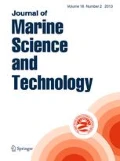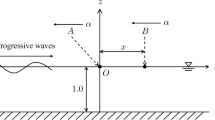Abstract
The present study focuses on wake wash management in the Bay of Naples by time variant spectral analysis to establish more reliable operational strategies and mitigative measures. The time frequency analysis of several wake wash signals due to high-speed craft (HSC), both catamarans and monohulls, operating in the Gulf of Naples is carried out to derive the time-energy per unit area distribution and better characterize the wake wash event and relevant spectrum. A new spectral analysis procedure, which allows to filter the wind sea wave component, is proposed to evaluate the only wake wash component and to estimate both wake wash height and energy density. In this respect, in fact, the influence of wind sea waves may lead to more reliable coastal management guidelines and wake wash measures, even if the measurement campaign has been carried out under calm met-ocean conditions. A comparative study with wake wash values determined by time history analysis is finally carried out, showing that spectral analysis can be applied with good confidence for coastal management purposes, leading to more accurate and reliable operational strategies.







Similar content being viewed by others
References
Begovic E, Benassai G, Nocerino E, Scamardella A (2007) Field investigation of wake wash generated by HSC in the Bay of Naples. In: The 2nd International Conference on Marine Research and Transportation, pp 243–252
Begovic E, Benassai G (2007) Wake Wash Analysis of HSC Catamarans. In: Proceedings of the international conference of international society of offshore and polar engineering ISOPE, Lisbon
Benassai G, Piscopo V, Scamardella A (2013) Field study on waves produced by HSC for coastal management. Ocean Coast Manag 82:138–145
Croad R, Parnell KE (2002) Proposed controls on shipping activity in the Marlborough Sounds: a review. Section 32 of the Resource Management Act. Report to Marlborough District Council
Didenkulova I, Sheremet A, Torsvik T, Soomere T (2012) Characteristic properties of different vessel wake signals. In: Conley DC, Masselink G, Russell PE, O’Hare TJ (eds) Proceedings 12th international coastal symposium (Plymouth, England), journal of coastal research, Special Issue No. 65, pp 213–218
Havelock TH (1908) The Propagation of Groups of Waves in Dispersive Media, with Application to Waves on Water produced by a Travelling Disturbance. In: Proceedings of the Royal Society of London, Series A, vol. LXXXI, pp 398–430
Kurennoy D, Parnell KE, Soomere T (2011) Fast-ferry generated waves in South-West Tallinn Bay. J Coast Res 64:165–169
Parnell KE, Kofoed-Hansen H (2001) Wakes from large high-speed ferries in confined coastal waters: Management approaches with examples from New Zealand and Denmark. J Coast Manag 29(3):217–237
Parnell KE, Mc Donald SC, Burke AE (2007) Shoreline effects of vessel wakes, Marlborough Sounds, New Zealand. Journal of Coastal Research, SI 50 (Proceedings of the 9th International Coastal Symposium), pp 502–506
Parnell KE, Delpeche N, Didenkulova I, Dolphin T, Erm A, Kask A, Kelpšaite L, Kurennoy D, Quak E, Räämet A, Soomere T, Terentjeva T, Torsvik T, Zaitseva-Pärnaste I (2008) Far-field vessel wakes in Tallinn Bay. Est J Eng 14(4):273–302
Quatieri TF (2002) Discrete time speech signal processing: principles and practice. Prentice Hall PTR
Robbins A, Thomas GA, Renilson MR, MacFarlane GJ, Dand I (2009) Vessel trans-critical wave wake, divergent wave angle and decay. Royal Institution of Naval Architects. Transactions. Part A. Int J Marit Eng 151(2):25–38
Sheremet A, Gravois U, Tian M (2013) Boat-wake statistics at Jensen Beach, Florida. J Waterw Port Coast Ocean Eng 139(4):286–294
Soomere T (2005) Fast ferry traffic as a qualitatively new forcing factor of environmental processes in non-tidal sea areas: a case study in Tallinn Bay, Baltic Sea. Environ Fluid Mech 5:293–323
Soomere T (2006) Nonlinear ship wake waves as a model of rogue waves and a source of danger to the coastal environment: a review. Oceanologia 48:185–202
Stumbo S, Fox K, Dvorak F, Elliot L (1998) The Prediction, Measurement and Analysis of Wake Wash from Marine Vessels. SNAME Pacific Northwest Section
Torsvik T, Soomere T (2009) Modelling of long waves from high speed ferries in coastal waters. J Coast Res SI56:1075–1079
Torsvik T, Didenkulova I, Soomere T, Parnell KE (2009) Variability in spatial patterns of long nonlinear waves from fast ferries in Tallinn Bay. Nonlinear Process Geophys 16(2):351–363
Author information
Authors and Affiliations
Corresponding author
About this article
Cite this article
Benassai, G., Piscopo, V. & Scamardella, A. Spectral analysis of waves produced by HSC for coastal management. J Mar Sci Technol 20, 417–428 (2015). https://doi.org/10.1007/s00773-014-0290-1
Received:
Accepted:
Published:
Issue Date:
DOI: https://doi.org/10.1007/s00773-014-0290-1




